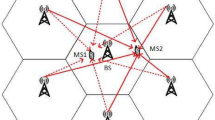Abstract
In this paper, we estimate characteristics of the IEEE 802.11 DCF (Distributed Coordination Function) in non-saturation mode. We take into account two significant features inherent to the non-saturated 802.11 DCF: (i) the possibility of asynchronous transmission performed without preceding backoff for the first packet arriving at the idle staion; and (ii) so-called post backoff meaning that a station must perform a backoff once after any of its transmissions even if its queue becomes empty. We derive the probability generating function (PGF) of Head-of-Line delay (HoL-delay). Our method to find PGF of HoL-delay is quite intuitive and straightforward. Also, we obtain the packet loss probability and non-saturation throughput. Numerical results show that these two features inherent to the non-saturated 802.11 DCF influence on the performance measures of DCF such as delay considerably and it should be taken into account for accurate modeling of DCF.
Similar content being viewed by others
References
Wireless LAN MAC and PHY Layer Specifications, LAN MAN Standards Committee of the IEEE Computer Society Std., ANSI/IEEE 802.11, 1999.
Bianchi, G., Performance Analysis of the IEEE 802.11 Distributed Coordination Function. IEEE J. Select. Areas Commun., 2000, vol. 18, no. 3, pp. 535–547.
Cali, F., Conti, M., and Gregori, E., Dynamic Tuning of the IEEE 802.11 Protocol to Achieve a Theoretical Throughput Limit, IEEE/ACM Trans. Networking, 2000, vol. 8, no. 6, pp. 785–799.
Foh, C.H. and Zukerman, M., Performance Analysis of the IEEE 802.11 MAC Protocol, Proc. European Wireless 2002 Conference, Florence, Italy, 2002, pp. 184–190.
Vishnevsky, V.M. and Lyakhov, A.I., IEEE 802.11 Wireless LAN: Saturation Throughput Analysis with Seizing Effect Consideration, Cluster Computing, 2002, no. 5, pp. 133–144.
Bianchi, G. and Tinnirello, I., Remarks on IEEE 802.11 DCF Performance Analysis, IEEE Commun. Letters, 2005, vol. 9, no. 8, pp. 765–767.
Foh, C.H. and Tantra, J.W., Comments on IEEE 802.11 Saturation Throughput Analysis with Freezing of Backoff Counters, IEEE Commun. Letters, 2005, vol. 9, no. 2, pp. 130–132.
Winands, E., Denteneer, T., Resing, J., and Rietman, R., A Finite-source Feedback Queueing Network as a Model for the IEEE 802.11 Distributed Coordination Function, Proc. 5th European Wireless Conference: Mobile and Wireless Systems beyond 3G, 2004.
Alizadeh-Shabdiz, F. and Subramaniam, S., A Finite Load Analytical Model for the IEEE 802.11 Distributed Coordination Function MAC, IEEE International Conference on Communications, 2004, vol. 1, pp. 175–179.
Litjens, R., Roijers, F., van den Berg, J., Boucherie, R., and Fleuren, M., Performance Analysis of Wireless LANs: An Integrated Packet/flow Level Approach, Proc. 18th International Teletraffic Congress, 2003.
Duffy, K., Malone, D., and Leith, D., Modeling the 802.11 Distributed Coordination Function in Non-saturated Conditions, IEEE Commun. Letters, 2005, vol. 9, no. 8, pp. 715–717.
Kim, T.O. and Choi, B.D. Performance Analysis of IEEE 802.11 DCF and IEEE 802.11e EDCA in Non-saturation Condition, IEICE Trans. Commun. (to be published).
Alazemi, H.M.K., Margolis, A., Choi, J., Vijaykumar, R., and Roy, S., Stochastic Modelling and Analysis of 802.11 DCF with Heterogeneous Non-saturated Nodes, Comp. Commun., 2007, vol. 30, no. 18, pp. 3652–3661.
Tickoo, O. and Sikdar, B., A Queueing Model for Finite Load IEEE 802.11 Random Access MAC, Proc. IEEE ICC, Paris, 2004.
Tickoo, O. and Sikdar, B., Queueing Analysis and Delay Mitigation in IEEE 802.11 Random Access MAC Based Wireless Networks, Proc. IEEE INFOCOM, Hong Kong, China, 2004.
Baranov, A.V. and Lyakhov, A.I., Estimating Performance of Arbitrarily Loaded Wireless Local-area Networks with IEEE 802.11 Protocol, Autom. Remote Control, 2005, vol. 66, no. 7, pp. 1101–1114.
Bae, Y.H., Kim, K.J., Moon, M.N., and Choi, B.D., Analysis of IEEE 802.11 Non-saturated DCF by Matrix Analytic Method, Annals Oper. Res. (to be published).
Neuts, M.F., Structured Stochastic Matrices of M/G/1 Type and Their Applications, New York: Marcel Dekker, 1989.
Author information
Authors and Affiliations
Additional information
Original Russian Text © Y.H. Bae, A.I. Lyakhov, V.M. Vishnevsky, K.J. Kim, B.D. Choi, 2008, published in Informatsionnye Protsessy, 2008, Vol. 8, No. 1, pp. 30–46.
This research is supported by the MIC, under the ITRC support program supervised by the IITA, and by the Russian Foundation for Basic Research, project no. 06-07-90929.
Rights and permissions
About this article
Cite this article
Bae, Y.H., Lyakhov, A.I., Vishnevsky, V.M. et al. Matrix method to study IEEE 802.11 network. Autom Remote Control 69, 529–543 (2008). https://doi.org/10.1134/S0005117908030181
Received:
Published:
Issue Date:
DOI: https://doi.org/10.1134/S0005117908030181




